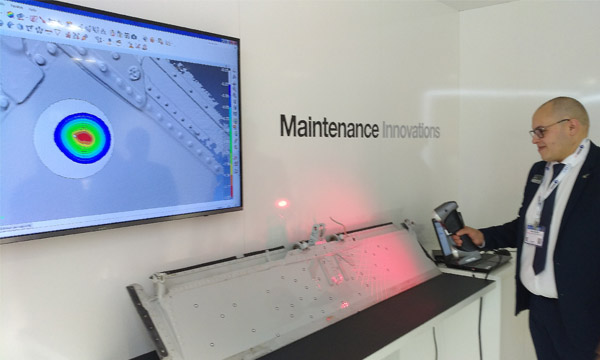Dassault develops its next generation of maintenance tools |
| Léo Barnier |
|
|
06 JUN 2019 | 658 words
|
 |
© L. Barnier / Le Journal de l'Aviation - all rights reserved |
|
|
|
Just as it is turning its MRO strategy upside down - with the consecutive buy-outs of Execujet and TAG Aviation at the start of the year - Dassault Aviation is also planning to strengthen its maintenance tools. The french aircraft manufacturer presented a 3D scanner to inspect and characterise faults on an aircraft structure during the EBACE convention in Geneva in mid-May. Developed at its Dassault Falcon Service maintenance subsidiary, it is now due to be shared across the Dassault support network.
This Scan 3D solution is intended first and foremost to be simple to deploy. It is based on a HandyScan 3D portable optical scanner - purchased off the shelf from the Canadian company Creaform (a subsidiary of the American Ametek group) for around 50 000 Euro - which calibrates on a set of reflective targets placed at random on the surface of the element to be analysed. It then creates its own reference base independently. The operator then only needs to sweep the zone with the scanner a few tens of centimetres away to map the surface precisely and the fault found on it.
Once acquisition is complete, the data is processed by a computer application, using InnovMetric's PolyWorks metrology software suite. This step enables the range or depth of the fault to be measured (dent, deformation, corrosion, etc.) by comparing it to an undamaged zone taken as a reference. These results can then be used directly by the support teams and design and calculation offices to determine whether the fault is acceptable, whether it needs to be repaired and ultimately how it should be repaired.
However, Scan 3D cannot observe beneath the surface. The fault then needs to be laid bare: in the case of corrosion, the whole coating needs to be removed first and the zone "scraped".
One third of the time
Using Scan 3D saves vast amounts of time, according to Sami Djoudi, structure repair engineer at Dassault Falcon Service. It takes around three minutes to scan a surface and as much again in retro-engineering to evaluate the fault's characteristics. In comparison, the traditional method requires measurements with a set of wedges between the damaged part and a corrected part. This is a task which he describes as laborious, with random repetition a potential source of error. The tedious nature of the work is therefore greatly reduced, in particular for the plane's hard to reach areas.
The level of precision of the data sent to the design and calculation offices also enables the number of exchanges with the maintenance operator to be limited. In the end, Jean Kayanakis, deputy chief executive in charge of Falcon customer service and the service station network, feels that the time needed to process this type of fault is reduced from around two weeks to a few days.
Deployment phase
For the moment, this solution is only deployed at Dassault Falcon Service, at Le Bourget and Mérignac. Following a maturity phase lasting around two years, it should be rolled out within the Falcon support network from this year.
"The product is now finished and ready to be integrated into the maintenance process. We are looking at how we can industrialise it and provide it to all the group's stations", explains Jean Kayanakis. Nor is he closing the door to selling or leasing this solution to maintenance centres approved by Dassault Aviation, but discussions are still on-going.
Scan 3D should continue to develop in the future. Dassault is working on being able to measure the mapped fault by comparing it directly to the 3D model of the plane, or by using thickness data collected by ultrasound on reference points around the affected area. The faults recorded are also archived in a database to speed up repair recommendations even further. Finally, the tool has caught the attention of Dassault Aviation's military arm and a specific version could be created.
|
|
 |
Léo Barnier
Specialized journalist
Industry & Technology, Equipments, MRO
|
|
| |
They made this section possible |
|
|
|
|
|
|
|
|
|
|
|
|
|
|
|
|
Top stories |
|
|
|
|
|
Top stories
|